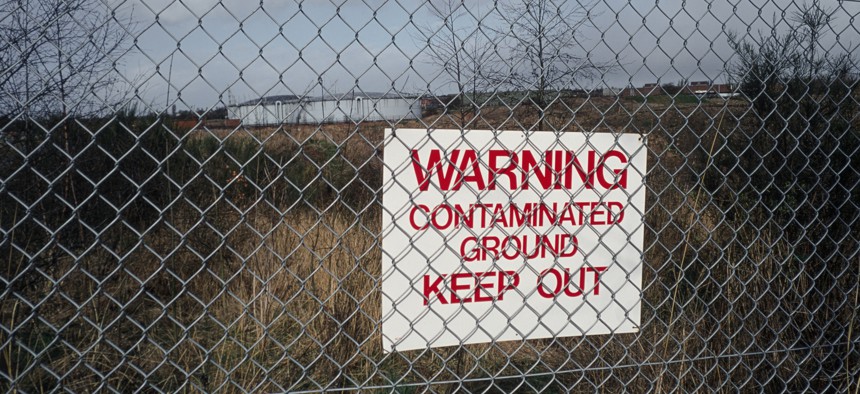There’s Bipartisan Interest in Reworking the Brownfields Program

Robert Brook/ Science Photo Library via Getty Images
The infrastructure law tripled funding to clean up and redevelop polluted sites. Two key senators are looking at ways to help more communities take advantage of the additional money.
The top Democratic and Republican lawmakers on the Senate public works committee signaled bipartisan interest on Wednesday in reworking the federal brownfields program, including helping rural and disadvantaged communities gain access to $1.5 billion in funding for it that is included in the Infrastructure Investment and Jobs Act.
Environment and Public Works chairman Sen. Tom Carper, a Delaware Democrat, noted during a hearing that the bipartisan, $1.2 trillion infrastructure package President Biden signed into law last year tripled funding for the program, which helps communities pay for cleaning up and redeveloping polluted sites.
“We must ensure that the program can use these resources to the greatest effect in assisting our cities, towns, rural communities, and tribes,” Carper said.
He added that he’d like to see “increased support for planning” to help “ensure that communities are better able to maximize the benefits of projects.”
Carper noted that Congress will be evaluating the program next year when it is due to be reauthorized.
Sen. Shelley Moore Capito, of West Virginia, the top Republican on the committee, said that rural communities, in particular, need help to compete with urban areas for the $1.2 billion in competitive brownfields grants in the infrastructure law.
Capito said the application process should be made easier, noting applicants typically only have 60 days to apply after the Environmental Protection Agency makes the grants available.
“Unlike larger cities and urban centers, local municipalities typically are operating on a shoestring budget, lack the good fortune of having multiple full-time grant writers on their staff,” Capito said. “This makes it an uphill battle for rural communities when they try to compete.”
Despite differences between Democrats and Republicans over environmental policy, Capito noted that the brownfields program has support from both parties.
“The brownfields program recognizes the vast untapped economic potential these contaminated sites can have after they have been successfully remediated,” said Capito, who is expected to head the committee should Republicans win control of the Senate in November’s elections.
“It’s a rare occasion when an EPA program enjoys strong bipartisan support along this committee’s dais,” she added.
Experts also called on the panel to simplify applying for the grants.
George Carico, director of Marshall University’s West Virginia Brownfields Assistance Center, which works with communities on brownfield projects, said the state has received $41 million in grants from the program since it was created in 2002. The money has gone to projects like the construction of a new library in Shepherdstown, West Virginia on what had been a town dump.
“While we have a lot of success stories, we have many, many more sites that still need attention, especially in our smaller communities in our rural areas,” he told the committee. “It's much more difficult for the smaller communities to compete against the larger cities in urban areas. Successfully applying for brownfield grant funding and meeting all the requirements can be a daunting challenge for these communities. And they're often at a disadvantage.”
The grant process is “overly burdensome,” agreed Michael Goldstein, managing partner of an environmental law firm in Florida that consults with cities and companies on brownfield projects.
“If we can streamline that, it would, I think, increase the competitiveness of not only rural communities but environmental justice communities who are also under-resourced, even though they're in urban areas,” Goldstein said, using a term to describe lower-income or otherwise disadvantaged areas that are often disproportionately affected by industrial pollution.
Despite the additional money in the infrastructure law, Goldstein said communities need to be able to use larger chunks of the funding to clean up sites.
Brad Buschur, project director of Groundwork Lawrence, a community redevelopment nonprofit in Lawrence, Massachusetts, echoed that view and noted that "off-site disposal and transportation costs have increased dramatically over the past five years.”
The grants also cannot be used to demolish structures, he said, adding that, “It's pretty wild that a mill building has to burn and the contaminants have to end up in the soils to be eligible.”
Gerald Pouncey, an Atlanta environmental and infrastructure attorney, agreed that while brownfield grants provide important funding for environmental assessments, “the real cost is on the cleanup side. And so raising the limit on the funds associated with cleanup is absolutely imperative in terms of allowing these programs to move forward.”
Pouncey also told the senators that the program needs to include more financial incentives for companies to take on the risk of redeveloping the sites. Projects often “require a significant upfront investment in capital and in cost for the testing that you do to determine if the site is even viable for redevelopment,” he said.
“You're making that investment with no certainty,” he said. “Often those test results may say that the redevelopment is not viable because of the level of impacts that exist at that site.”
State programs, like in Georgia, offer incentives, such as making site cleanup costs tax deductible, he said.
Goldstein agreed, and called for low-income housing projects on remediated sites to be eligible for higher tax credits than in other areas to help attract private investment, “and just make it a bad business decision to ignore rural communities and environmental justice communities.”
Kery Murakami is a senior reporter for Route Fifty.
NEXT STORY: How one fire department’s ‘crawl, walk, run’ mantra guides its drone use






